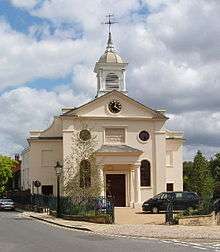Proprietary chapel
A proprietary chapel is a chapel that originally belonged to a private person, but with the intention that it would be open to the public, rather than restricted (as with private chapels in the stricter sense) to members of a family or household, or members of an institution. Generally, however, some of the seating - sometimes a substantial proportion—would be reserved for subscribers.[1] In 19th-century Britain they were common, often being built to cope with urbanisation. Frequently they were set up by evangelical philanthropists with a vision of spreading Christianity in cities whose needs could no longer be met by the parishes. Some functioned more privately, with a wealthy person building a chapel so they could invite their favourite preachers.[2] They are anomalies in English ecclesiastical law, having no parish area, but being able to have an Anglican clergyman licensed there. Historically many Anglican churches were proprietary chapels. Over the years they have often been converted into normal parishes (for example Redland Parish Church in Bristol).
During the first half of the nineteenth century "proprietary" chapels flourished in Belgravia, Bath, and other fashionable resorts. They were extra-parochial, and were often run on a commercial basis, supported by pew-rents and sometimes built over wine vaults ... An ingratiating preacher, preferably an invalid ..., a well-nourished verger, and genteel pew-openers did their best to attract the quality ... An advertisement from the Times (1852) gives a good idea of the "ethos" of the proprietary chapel "A young man of family, evangelically disposed, and to whom salary is no object, may hear of a cure in a fashionable West End congregation by addressing the Reverend A.M.O. at Hatchards, Boosellers, Piccadilly."[3]

Today there are still a number of functioning Anglican churches which are proprietary chapels, including one in Avonwick in Devon; Emmanuel Church, Wimbledon;[4] St John's Downshire Hill Hampstead;[5] and St James' Ryde[6] on the Isle of Wight.
Another functioning Anglican church which is a proprietary chapel is St Peter-in-Ely.[7] Catharine Maria Sparke, widow of Canon Edward Bowyer Sparke, decided to build a church in memory of her husband who had been keenly aware of the need for a church for Ely's riverside district. On St Peter's Day, 1889 the foundation stone was laid and on Monday 30 June 1890 the church was dedicated to St Peter by the Bishop of Ely, Lord Alwyne Compton (bishop).
Christ Church, Bath[8] was found in 1798 in order that those who could not afford pew rents would have somewhere to worship. It remains a proprietary chapel, with a board of Trustees as well as a Church Council.
St Mary's Church, Castle Street, Reading[9] (not to be confused with the larger but similarly named Minster Church of St Mary the Virgin, which is only a few yards away) is an extant church which formerly functioned as a proprietary chapel within the Anglican Church, but now forms part of the Church of England (Continuing).
St John the Evangelist's Church, Chichester[10] is a redundant church which is now in the care of the Churches Conservation Trust but it is still used for concerts and occasional services.
St Ninian's Church, Whitby[11] was formerly a proprietary chapel. Since leaving the Church of England in the 1990s, it has been successively a part of the Holy Catholic Church (Western Rite), the Anglican Catholic Church (UK) and the Catholic Church of England and Wales (CCEW)[12], all recent breakaway groups.
St John's Chapel, Bedford Row (demolished 1863) was formerly a proprietary chapel.
See also
References
- See the further discussion of this in St John the Evangelist's Church, Chichester.
- St James' Church Archived 2008-05-09 at the Wayback Machine; Church Society
- Drummond, Andrew L. (1950). The Churches in English Fiction. Leicester: Edgar Backus. pp. 30–31.
- "Emmanuel Church, Wimbledon". Retrieved 11 January 2015.
- "St Johns Church, Downshire Hill". Archived from the original on 21 December 2003. Retrieved 17 January 2015.
- "St James's Church, Ryde". Retrieved 17 January 2015.
- "St Peter in Ely". St Peter in Ely. Retrieved 15 December 2018.
- "Christ Church, Bath". Retrieved 19 January 2019.
- "St. Mary's Church, Reading". Archived from the original on 5 August 2010. Retrieved 11 January 2015.
- "St. John's Chapel, Chichester". Retrieved 17 January 2015.
- "St Ninian's, Whitby". Retrieved 19 January 2019.
- "Roman Catholic Church of England and Wales". Retrieved 19 January 2019.